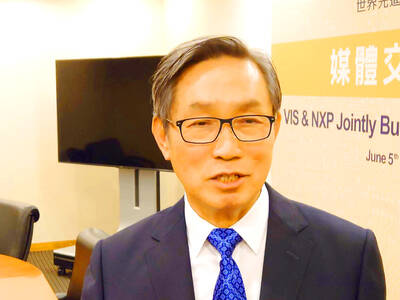After two years of partnership, Asustek Computer Inc (華碩) and Garmin Ltd, the US’ No. 1 portable navigation devices maker, are calling it quits.
Asustek, the world’s No. 5 PC brand, yesterday confirmed that both parties agreed to scrap their “co-branding” strategy starting from next year.
That means consumers will no longer find smartphones that bear the “Garmin-Asus” logo in the future because Garmin has decided to pull out of the smartphone business, Asustek corporate vice president Benson Lin (林宗樑) told a media briefing.
“Navigation smartphones need more time to take off ... We are not keeping up with industry changes and are losing competitiveness,” Lin said.
Ending the co-branding partnership will allow the companies to “focus on [their] respective core competencies,” he said.
Asustek and Garmin teamed up in January last year to introduce co-branded smartphones, with Asustek managing the hardware and Garmin supplying the navigation solutions.
The two companies had plans to officially launch a joint venture this year to enhance the partnership, but the idea was scrapped after sales of Garmin-Asus phones hit a snag in the US amid strong competition from Apple’s iPhone and the wide availability of Google Maps in other smartphones, Lin said.
After the split, Asustek will market handhelds carrying the “Asus” logo, and Garmin will offer exclusive rights to its navigation software to Asustek’s Android-based smartphones “for a few years,” he said, declining to detail the licensing terms.
The split also means Garmin will be able to market its navigation solutions on other app markets for non-Android-based handsets. These include Apple Inc’s App Store and Research In Motion Ltd’s App World.
Garmin’s Dutch rival TomTom NV is selling navigation apps on App Store for US$49.99 for Hong Kong users, US$89.99 for West European users and US$59.99 for US users.
If consumers just get a Garmin-Asus phone, they won’t be able to realize the hidden values offered by Garmin solutions, Lin added.
The two partners had launched six Garmin-Asus smartphones over the last two years, mostly to lukewarm reception. Asustek’s earlier target to ship 1 million smartphones this year remains challenging, analysts said.
The company is hoping that its recent foray into TD-SCDMA phones for the Chinese market will bear fruit and help expand sales.
Lin said Asustek would launch two models running on China’s proprietary 4G standard by the end of the year, adding that the firm was in talks to bundle phone sales through China Mobile Ltd (中國移動), the world’s largest mobile operator by number of subscribers.

TARIFFS: The global ‘panic atmosphere remains strong,’ and foreign investors have continued to sell their holdings since the start of the year, the Ministry of Finance said The government yesterday authorized the activation of its NT$500 billion (US$15.15 billion) National Stabilization Fund (NSF) to prop up the local stock market after two days of sharp falls in reaction to US President Donald Trump’s new import tariffs. The Ministry of Finance said in a statement after the market close that the steering committee of the fund had been given the go-ahead to intervene in the market to bolster Taiwanese shares in a time of crisis. The fund has been authorized to use its assets “to carry out market stabilization tasks as appropriate to maintain the stability of Taiwan’s

STEEP DECLINE: Yesterday’s drop was the third-steepest in its history, the steepest being Monday’s drop in the wake of the tariff announcement on Wednesday last week Taiwanese stocks continued their heavy sell-off yesterday, as concerns over US tariffs and unwinding of leveraged bets weighed on the market. The benchmark TAIEX plunged 1,068.19 points, or 5.79 percent, to 17,391.76, notching the biggest drop among Asian peers as it hit a 15-month low. The decline came even after the government on late Tuesday authorized the NT$500 billion (US$15.2 billion) National Stabilization Fund (國安基金) to step in to buoy the market amid investors’ worries over tariffs imposed by US President Donald Trump. Yesterday’s decline was the third-steepest in its history, trailing only the declines of 2,065.87 points on Monday and

TARIFF CONCERNS: The chipmaker cited global uncertainty from US tariffs and a weakening economic outlook, but said its Singapore expansion remains on track Vanguard International Semiconductor Corp (世界先進), a foundry service provider specializing in producing power management and display driver chips, yesterday withdrew its full-year revenue projection of moderate growth for this year, as escalating US tariff tensions raised uncertainty and concern about a potential economic recession. The Hsinchu-based chipmaker in February said revenues this year would grow mildly from last year based on improving supply chain inventory levels and market demand. At the time, it also anticipated gradual quarter revenue growth. However, the US’ sweeping tariff policy has upended the industry’s supply chains and weakened economic prospects for the world economy, it said. “Now

An employment discrimination lawsuit against contract chipmaker Taiwan Semiconductor Manufacturing Co (TSMC, 台積電) might soon be expanded after a hearing in a federal court in San Jose, California, on Tuesday to add 15 plaintiffs to the case. According to a court document, the lawsuit, which was refiled in November last year as a form of a class action with 13 plaintiffs in California, wants to add 15 plaintiffs from Arizona, where TSMC is building up its wafer fab capacity. TSMC first committed between 2020 and last year to invest US$65 billion in three advanced wafer fabs in Arizona. It then pledged an